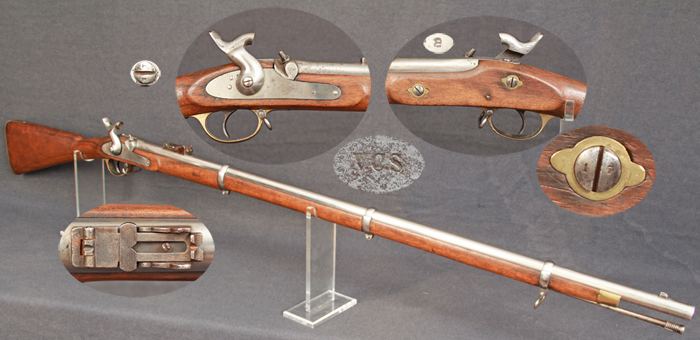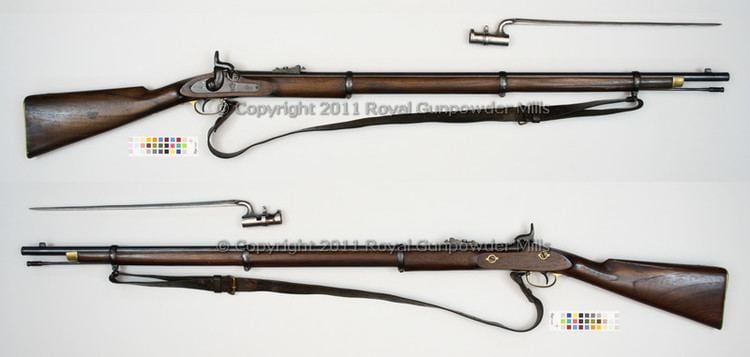In service 1853–1889 | ||
 | ||
Used by United Kingdom & ColoniesUnited States of AmericaConfederate States of AmericaJapanDenmarkEmpire of Brazil Wars Indian MutinyCrimean WarNew Zealand Land WarsUS Civil WarBoshin WarParaguayan WarFenian raidsRed River RebellionSecond Schleswig War | ||
The Enfield Pattern 1853 rifle-musket (also known as the Pattern 1853 Enfield, P53 Enfield, and Enfield rifle-musket) was a .577 calibre Minié-type muzzle-loading rifle-musket, used by the British Empire from 1853 to 1867, after which many Enfield 1853 rifle-muskets were converted to (and replaced in service by) the cartridge-loaded Snider-Enfield rifle.
Contents
- History and development
- Crimean War
- Indian Rebellion of 1857
- New Zealand Land Wars
- American Civil War
- Reproductions
- References

History and development

The term “rifle-musket” originally referred to muskets with the smooth-bored barrels replaced with rifled barrels. The length of the barrels were unchanged, allowing the weapons to be fired by rank, since a long rifle was necessary to enable the muzzles of the second rank of soldiers to project beyond the faces of the men in front. The weapon would also be sufficiently long when fitted with a bayonet to be effective against cavalry. Such guns manufactured with rifled barrels, muzzle loading, single shot, and utilizing the same firing mechanism, also came to be called rifle-muskets.

The 39 in (99 cm) barrel had three grooves, with a 1:78 rifling twist, and was fastened to the stock with three metal bands, so that the rifle was often called a "three band" model.
The rifle's cartridges contained 68 grains (4.4 g) of black powder, and the ball was typically a 530-grain (34 g) Pritchett or a Burton-Minié, which would be driven out at about 850 to 900 feet (259 - 274m) per second. It was developed by William Pritchett in the 1850s.
The Enfield’s adjustable ladder rear sight had steps for 100 yards (91 m) – the default or “battle sight” range – 200 yards (180 m), 300 yards (270 m), and 400 yards (370 m). For distances beyond that, an adjustable flip-up blade sight was graduated (depending on the model and date of manufacture) from 900 yards (820 m) to 1,250 yards (1,140 m). British soldiers were trained to hit a target 6 feet (180 cm) by 2 feet (61 cm) – with a 2 feet (61 cm) diameter bull's eye, counting 2 points – out to 600 yards (550 m). The target used from 650 yards (590 m) to 900 yards (820 m) had a 3 feet (91 cm) bull's eye, with any man scoring 7 points with 20 rounds at that range being designated a marksman.
Crimean War

With war breaking out between the Russians and the Turks, Britain realized that it was only a matter of time before they would be drawn into the conflict. The British Army was in the midst of a significant weapons transformation from smoothbore muskets to rifled muskets. While three of the four divisions of the field army in the Crimea had been supplied with the pattern 1851 Minie rifle-musket, the other regiments of the army around the Empire still carried the 1842 pattern smoothbore musket. By the end of 1853, the Enfield rifle-musket was approved by the War Department for the army and was put into production. The Enfield saw extensive action in the Crimean War, 1854–1856, with the first Enfield rifles being issued to troops from February 1855.
Indian Rebellion of 1857
The Enfield P53 was introduced to Indian troops under British colonization in 1856. The Enfield rifle-musket was a contributing cause of the Indian rebellion of 1857. Sepoys in the British East India Company's armies in India were issued with the new rifle in 1857, and rumours began to spread that the cartridges (referring here to paper-wrapped powder and projectile, not to metallic cartridges) were greased with beef tallow, lard, or a combination of the two - a possibility abhorrent to both Hindu and Muslim soldiers for religious reasons.
British military drills of the time required soldiers to bite open the cartridge, pour the gunpowder contained within down the barrel, ram the cartridge (which included the bullet) down the barrel, remove the ram-rod, bring the rifle to the ready, set the sights, add a percussion cap, present the rifle, and fire. The musketry books also recommended that, "Whenever the grease around the bullet appears to be melted away, or otherwise removed from the cartridge, the sides of the bullet should be made wet in the mouth before putting it into the barrel; the saliva will serve the purpose of grease for the time being".
The idea of having anything which might be tainted with pig or beef fat in their mouths was totally unacceptable to the native soldiers, and when they objected it was suggested that they were more than welcome to make up their own batches of cartridges, using a religiously acceptable greasing agent such as ghee or vegetable oil. This seemed to prove that the issued cartridges were, in fact, greased with pig and/or beef fat. A further suggestion that the sepoys tear the cartridges open with their hands (instead of biting them open) was rejected as impractical - many of the sepoys had been undertaking musket drill daily for years, and the practice of biting the cartridge open was second nature to them. Incidentally, after the Mutiny, manuals amended the method of opening the cartridge to, "Bring the cartridge to the forefinger and thumb of the left hand, and with the arm close to the body, carefully tear off the end without spilling the powder." The indifference of many British commanding officers to the problem perceived by the sepoys only added more fuel to the already volatile situation, and helped spark the First War for Independence in 1857.
As a consequence of British fears, the native infantry's long arms were modified by reaming out the rifling of the Pattern 1853 as a smooth bore bullet does not require greasing. This greatly reduced the gun's effectiveness, as did replacing the variable distance rear sight to a fixed sight. This became the Pattern 1858. However, due to the new thinner walls, the barrel would bulge and bursting was not an unknown problem. Furthermore, with the bayonet fitted excessive flexing became an issue. To remedy this, new barrels were made with thicker walls. This became the Pattern 1859.
New Zealand Land Wars
The Enfield 1853 rifle-musket was issued to the British Army regiments, colonial Militia and Volunteer units and later to the New Zealand Armed Constabulary, and saw extensive use in the mid and latter stages of the New Zealand Land Wars between 1845 and 1872. The first Enfield rifles were issued to the 58th and 65th Regiments, stationed in the country, in 1858. The Enfield was not the ideal weapon for use in the dense bush covered hills of New Zealand because of its long length and weight. Special units called Forest Rangers were formed to fight rebels in the bush but after their first expedition into the bush covered hills of the Hunua ranges, south of Auckland, most Enfields were returned and replaced with a mixture of much shorter and lighter, Calisher and Terry breech loading carbines, and Colt Navy .36 and Beaumont–Adams .44 revolvers. The special units kept a handful of 1853 Enfields for long range sniping. The Enfields continued to be used by the many British line regiments in the more open fern and tussock covered country of the Waikato interior.
Numbers of Enfield muskets were also acquired by the Maori later on in the proceedings, either from the British themselves (who traded them to friendly tribes) or from European traders who were less discriminating about which customers they supplied with firearms, powder, and shot. After the introduction of the Snider-Enfield, many of the Enfield Muskets in the Armed Constabulary's armouries were sold off to members of the public, and they remained a popular sporting and hunting arm in New Zealand well into the late 19th century, long after the introduction of metallic cartridge-loading firearms.
American Civil War
The Enfield 1853 rifle-musket was also used by both the North and the South in the American Civil War, and was the second most widely used infantry weapon in the war, surpassed only by the Springfield Model 1861 Rifled Musket. The Confederates imported more Enfields during the course of the war than any other small arm, buying from private contractors and gun runners. It has been estimated that over 900,000 P53 Enfields were imported to America and saw service in every major engagement from the Battle of Shiloh (April, 1862) and the Siege of Vicksburg (May 1863), to the final battles of 1865. The gun was highly sought after in the Confederate ranks. According to a survey taken by British officials during the early stages of war on the arms of the Western Confederate Forces, nearly 70% were armed with smoothbore arms, such as the Model 1842 Springfield, among others. Later in the war the same survey was taken, they found that more than 75% had attained a rifle and most being the Pattern 1853 Enfield.
Reproductions
The Enfield 1853 rifle-musket is highly sought after by black powder shooters and hunters, US Civil War re-enactors, and British Military firearms enthusiasts for its quality, accuracy, and reliability. The Italian firms of Davide Pedersoli & C. and Armi Chiappa (Armi Sport) manufacture a modern reproduction of the Enfield 1853 rifle-musket, which is readily available on the civilian market. Davide Pedersoli's reproductions are imported into the United States by the Italian Firearms Group located in Amarillo, Texas.
The British company of Parker Hale also produced numbers of reproductions of the Enfield 1853 rifle-musket and of the Pattern 1861 Enfield musketoon in the 1970s. Those pieces were made to original patterns but, are not particularly suitable for use in the American Civil War/War Between the States reenactors because they were made to 4th model specs including having the Baddeley barrel bands. This (the 4th) model was originally made too late to have been fielded in the American War. Appropriate models for that use would be 2nd or 3rd model three band rifle muskets.
